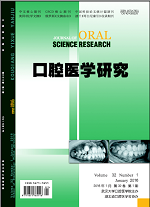|
|
Factors Affecting the Success Rate of Miniscrewsas Orthodontic Anchorage.
CAO Xiao-qing, ZHANG Li, LIU Long-kun.
2016, 32(1):
79-82.
DOI: 10.11839/kqyxzh.2016.01.020
Objective: To evaluate various factors that influencing the success rate of miniscrews used as orthodontic anchorage. Methods: 114 patients were included with a total of 253 miniscrews. Potential confounding variables examined were gender, age, vertical (FMA) and sagittal (ANB) skeletal facial pattern, site of placement (labial and buccal, palatal and retromandibular triangle), jaw of placement (maxilla and mandible), soft tissue type, oral hygiene, diameter and length of miniscrews, insertion method (predrilled or drill-free), angle of placement, onset and strength of force application and clinical purpose. The correlations between success rate and overall variables were investigated by logistic regression analysis, and the effect of each variable on the success rate was utilized by variance analysis. Results: The overall success rate was 88.54% with an average loading period of 9.5 months in successful cases. Age, oral hygiene, vertical skeletal facial pattern (FMA) and general placement sites (maxilla and mandibular) presented significant differences in success rates both by logistic regression analysis and variance analysis (P<0.05). Conclusion: To minimize the failure of miniscrews, proper oral hygiene instruction and effective supervision should be given for patients, especially the young (<12 years) high-angle patients with miniscrews placed in the mandible.
References |
Related Articles |
Metrics
|

